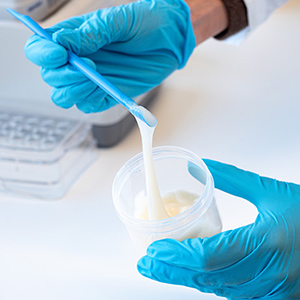The thin mycelial film is almost transparent and has good tensile strength. It could be used as a living bioplastic. Picture: Empa
(IN BRIEF) Empa researchers have developed a new biodegradable material using fungal mycelium, which shows great potential for various applications. This material, which uses the mycelium’s natural extracellular matrix, is tear-resistant and can be used as a plastic-like film or an emulsifier in liquids. The material is fully biodegradable, non-toxic, and even edible. Beyond these applications, it also shows promise in sustainable electronics and waste management. This research paves the way for a new generation of eco-friendly materials with wide-ranging uses across industries.
(PRESS RELEASE) DÜBENDORF, 13-MaY-2025 — /EuropaWire/ — Empa researchers have developed a groundbreaking biodegradable material made from fungal mycelium, which holds great promise for future applications in sustainable materials science. This innovative material, based on the extracellular matrix of the mycelium, combines the fungus’s natural properties with additional optimization, resulting in a unique, versatile material that is both biodegradable and tear-resistant.

Thanks to the auxiliary molecules in their extracellular matrix, the mycelial fibers are good natural emulsifiers – they are even safe to eat. Image: Empa
Mycelium, the root-like network of fungi, has long been a subject of interest for researchers looking to create eco-friendly alternatives to traditional materials. Empa researchers have taken a novel approach by using the mycelium and its extracellular matrix as-is, avoiding the typical trade-off between performance and sustainability seen with other biodegradable materials like cellulose and chitin. The result is a material that retains the benefits of biodegradability, is tear-resistant, and boasts a range of functional properties—all with minimal processing and no chemicals.
The key to the material’s strength lies in the extracellular matrix, a structure the fungus creates naturally as it grows. By selecting a strain of the split-gill mushroom (a widely edible fungus) known for producing high levels of two important macromolecules, schizophyllan and hydrophobin, the researchers were able to enhance the mycelial material’s performance. Schizophyllan is a long-chain polysaccharide, which acts as a fiber that strengthens the structure, while hydrophobin is a protein that acts as a natural emulsifier, allowing the material to interact with liquids in unique ways.

The fungal culture of the split-gill mushroom on a culture medium. Samples were taken from the Petri dish on the right. Image: Empa
Empa’s researchers showcased two applications for this living material in their recent study published in Advanced Materials. The first is a thin, plastic-like film, which has good tensile strength and could be used for a range of material applications. The second is an emulsion, where the mycelium’s natural emulsifiers help stabilize mixtures of liquids that would otherwise separate over time. These applications are especially valuable in industries like cosmetics and food, where stability is key.
“The fungus not only provides a biodegradable material but also contributes to stabilizing emulsions over time, making it ideal for applications where longevity is essential,” said Ashutosh Sinha, one of the lead researchers. He further added, “The potential for this material to be used in food and cosmetics is exciting because it’s both non-toxic and edible.”

The fungal film reacts reversibly to moisture and could be used for bio-based humidity sensors. Image: Empa
Beyond emulsifiers and films, the mycelium’s unique properties have extended to other exciting fields, including sustainable electronics. Empa’s researchers have found that the mycelium reacts reversibly to moisture, making it a candidate for bio-based humidity sensors. Additionally, they are exploring its use in the development of biodegradable batteries by combining the mycelium with other research projects like fungal biobatteries.
The versatile mycelial material also holds promise for applications like compostable bags that could actively decompose organic waste, turning waste management into a more sustainable process.
In conclusion, this innovative living mycelial material demonstrates a promising future for sustainable and biodegradable alternatives to traditional materials. It opens up numerous possibilities across industries while staying true to the principles of sustainability.
———-
First published in this link of EuropaWIRE.


